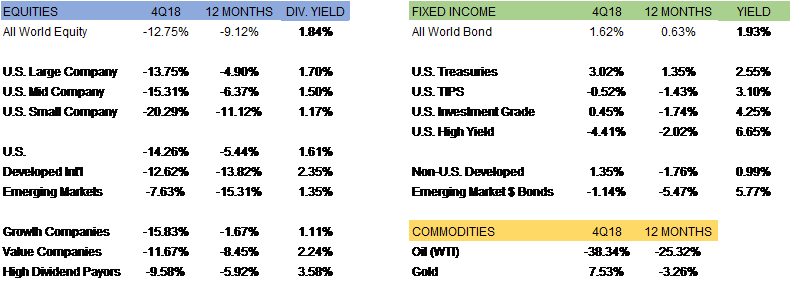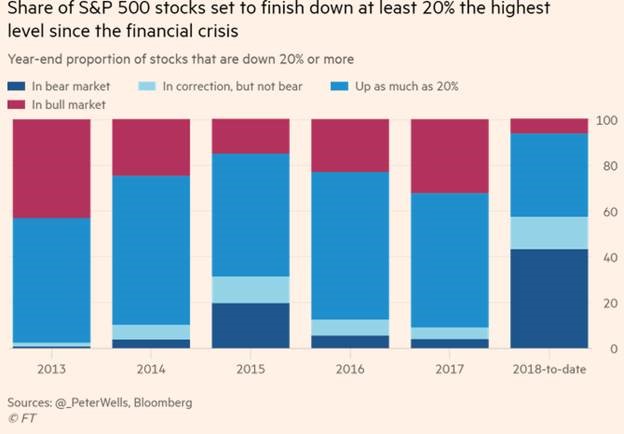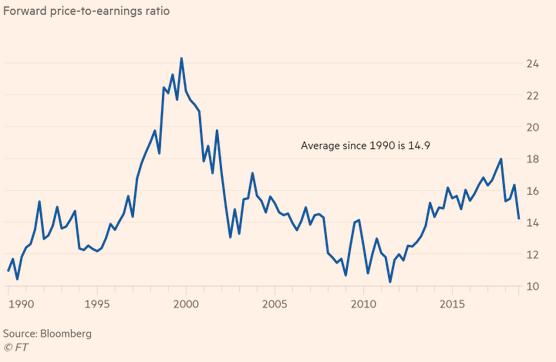The fourth quarter ended in rough shape with major equity markets around the globe experiencing one of the worst ends to a calendar year. Equity markets peaked in September when many hoped the U.S. growth engine would be able to lessen the pain from international uncertainty. Unfortunately, that did not last as trade concerns grew and international economic reading deteriorated. U.S. growth companies were particularly hit hard. With their high exposure to international markets and being some of the biggest beneficiaries of global trade, market participants decided that the risk of holding them was too large.
Growth companies experienced a 15% decline from the prior quarter end but, even with the correction, outpaced their value peers over the year. The gap between growth and value that we highlighted in our 3Q18 report shrunk but continues to be historically high. Smaller companies continued their underperformance as liquidity drained from the equity markets and investors moved to a lower level of risk tolerance.
The softness throughout 2018 in the U.S. Treasury market reversed as investors looked for protection. With the increasing concerns of a soft global economy and no signs of runaway inflation, interest rates fell as investors rand for safety.
Fear took hold in the fourth quarter, replacing the high level of greed being displayed entering 2018.

Building the Jigsaw Puzzle
Hopefully, with the end of the year came down time relaxing with your family and friends. For many of us, a sideshow at these gatherings is the jigsaw puzzle table. When you do your part assembling the 2,000 tiny pieces into the picture on the box, next time you might be struck, as we were, by the similarities between doing puzzles and investing.
With only a small sliver of the picture on each piece, intricate puzzles are overwhelming. The process (or at least the best process we have found) is to begin with the edges, which gives you somewhere to start and creates a frame to which you can tether the rest of the pieces. Next, we piece together distinguishing elements of the picture—the yellow bridge and the red pagoda, say, not the sky. With the picture framed and the major elements defined, filling in the rest of the puzzle just comes down to patience.
Circling the puzzle table, looking for that one piece with the perfect combination of blue and pink, is a lot like investing, although with investing, the picture is constantly changing. Over the last year, we defined the frame of the investment landscape: a market entering a period of increased instability, yet with the U.S. financial system healthy, thereby making a material and enduring downturn unlikely. More recently, we have been describing the important features of this market, recognizing the relative strength in the U.S. vs. the growing weakness in many international markets and acknowledging the fear that we might be seeing a headwind for all.
At Auour, as we filled in the distinguishing elements of the puzzle, we became more defensive, adding increasing levels of cash to portfolios. Today, we have entered the period requiring patience, where we painstakingly fill in, or—in the case of hyperbolic investment headlines—discard less-than-useful data until the picture is clear. We have reached a time when caution is warranted, but the odds tell us that the worst is likely over. We are waiting to see how the remaining pieces fit together, and the picture becoming clear will catalyze our full re-entry into the market.

December was an ugly end to 2018. The stock prices of a large swath of companies entered bear market territory (i.e., were down more than 20 percent). Much of that move was driven, we think, by a fear that the good times were ending and darker times were staring us in the face. We don’t think that fear was justified by the volume of data at hand. We see most of the movement as fear.
Our current reading of the data signals, with no guarantee that it will continue, is that the U.S. has structural strength that should provide valuation support to the market.
Let’s look at some of the pretty parts of the puzzle.

Unemployment is lower than it’s been since 2000, and wage growth is accelerating. This profile is not something that we historically see immediately before an economic downturn. In past episodes, fundamental factors start to weaken, signaling a buildup of instability within the consumption figures. The current metrics do not yet signal that stretched scenario.
Another important element in the investment picture is current valuation. With the significant stock price declines we saw in the fourth quarter, valuation metrics have declined to a historically favorable position. We remind you that valuation is not a signal we use for timing changes in position. Rather, it expresses the longer-term attractiveness (or risk) of the markets. Though not at historic lows, valuation measures today have declined to a point that argues we should be thinking about re-entering the market rather than exiting it. This is especially true when you consider the state of the bond market and the interest rates it is generating today.

